Call it Bhakarwadi or Bakarwadi, the fact that this snack is a super popular one in western India, doesn’t change. From the looks of it, it basically is a crisp, fried pinwheel or spiral and may really appear to involve a difficult procedure to prepare it. This, may not be completely false. But if you are ready to put in some efforts and follow this Bhakarwadi Recipe to bits, you’ll be able to recreate the magic of this addictive, sweet, spicy and tangy snack at your home.
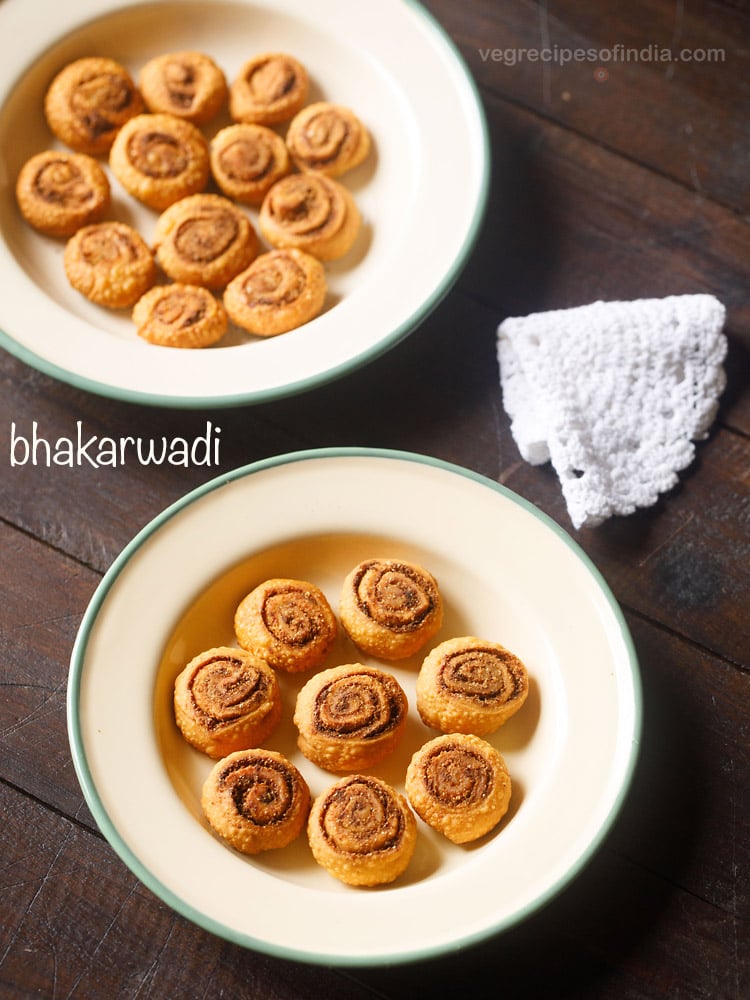
What is Bhakarwadi
More popular as Bhakarwadi in Gujarat, this scrumptious fried snack slightly alters its name and becomes the Bakarwadi in Maharashtra. As mentioned right at the beginning of this post, a traditional Bhakarwadi Recipe result in crisp, golden fried pinwheels or spirals, stuffed with a sweet, spicy and tangy mixture.
The most classic recipes of this super yum snack involve a spiced gram flour (besan) and all-purpose flour (maida) dough, with a filling made of coconut, poppy seeds, sesame seeds, spices as some of the primary ingredients. This is then stuffed, rolled, cut into discs and fried to perfection. However, there are a few elements that I have added in my Bhakarwadi Recipe to make it all the more awesome.
An interesting thing about the history of Bakarwadi is that it has been famous, from before 1960. This was the time when both Gujarat and Maharashtra collectively formed the Bombay State. Thus, both these cultures influenced the recipe of Bhakarwadi with their own unique flavors.
Broadly classifying, the brands that are said to have popularized this snack are Chitale from Pune, Maharashtra and Jagdish-Farsan from Vadodara, Gujarat. These have been the big players in the market since 1976 and 1938, respectively. They’ve played an important role in the distribution of this yummylicious snack, both nationally as well as internationally.
In the Maharashtrian version of Bakarwadi, the outer cover is made from gram flour (besan) and all-purpose flour (maida) or whole wheat flour (atta). The stuffing has coconut, sesame seeds, poppy seeds with some spices added in it.
A souring element is a must in the stuffing, to give bring in a certain tang in the Bhakarwadi. So, ingredients like lemon juice, tamarind pulp or even dried mango powder (amchur powder) may be added. For the sweetness, sugar is added.
Some versions of the Bhakarwadi Recipe also add Sev (fried gram flour vermicelli). Although, I have given it a miss in my recipe, but you can definitely add it, if you want. This recipe of mine is also not very spicy. You can increase the quantity of the Kashmiri red chili powder for a spicier version.
As I also said, making this snack is easy, but takes time and efforts. So, you’ll have to keep patience throughout the entire procedure of making the Bhakarwadi. Once done, it will be completely worth. Bakarwadi can be stored well in air-tight jars for many weeks. This recipe yields about 25 to 26 pinwheels.
How to make Bhakarwadi
For ease of understanding, I have divided this recipe post into 4 steps:
- Step 1 – Making dough
- Step 2 – Making stuffing
- Step 3 – Assembling and making Bhakarwadi
- Step 4 – Frying Bhakarwadi
Making dough
1. In a mixing bowl, large tray or plate, take 1 cup (100 grams) gram flour (besan) and ¾ cup (90 to 95 grams) all-purpose flour (maida). Also, add ¼ teaspoon turmeric powder, 1 pinch asafoetida (hing) and ¾ to 1 teaspoon salt.
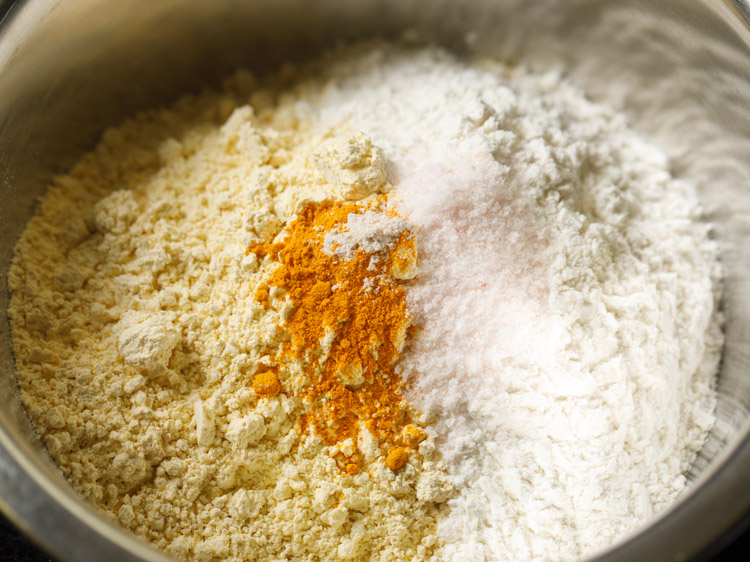
2. With a spoon, mix everything well.
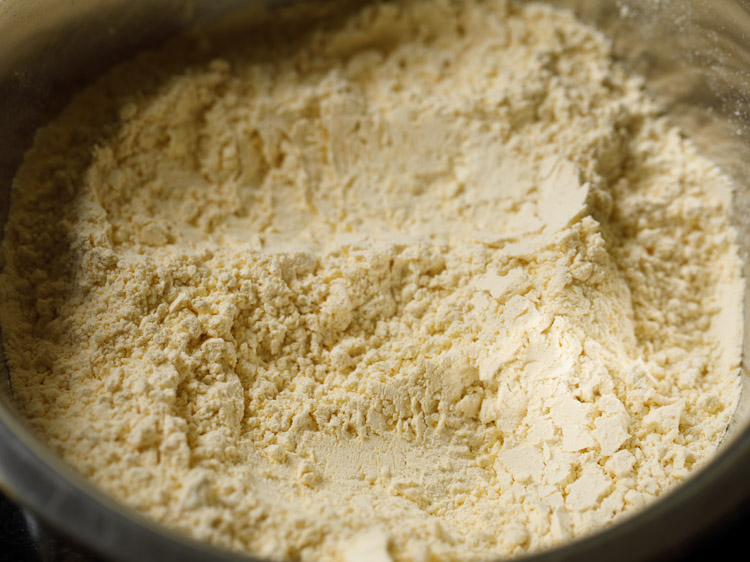
3. Next, add 3 tablespoons oil.
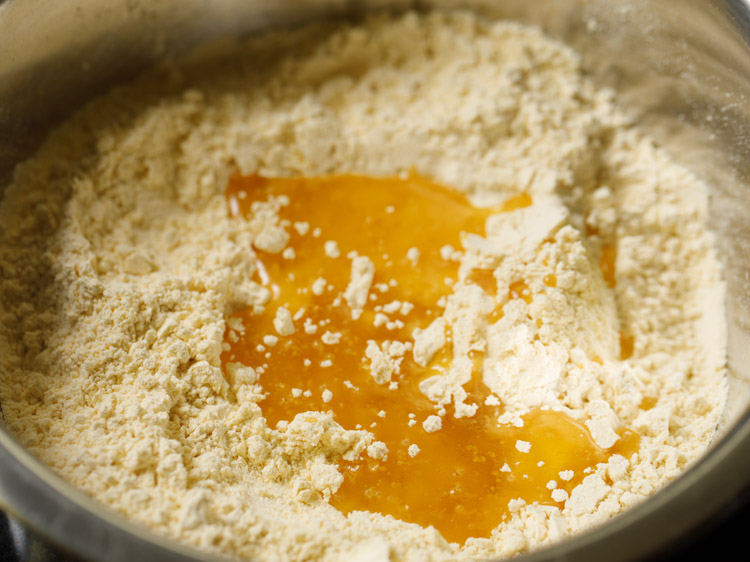
4. With your fingertips, mix the oil with the flours, till you get a breadcrumb like texture. Take a portion of the flour and press it. It should be able to hold itself and not crumble.
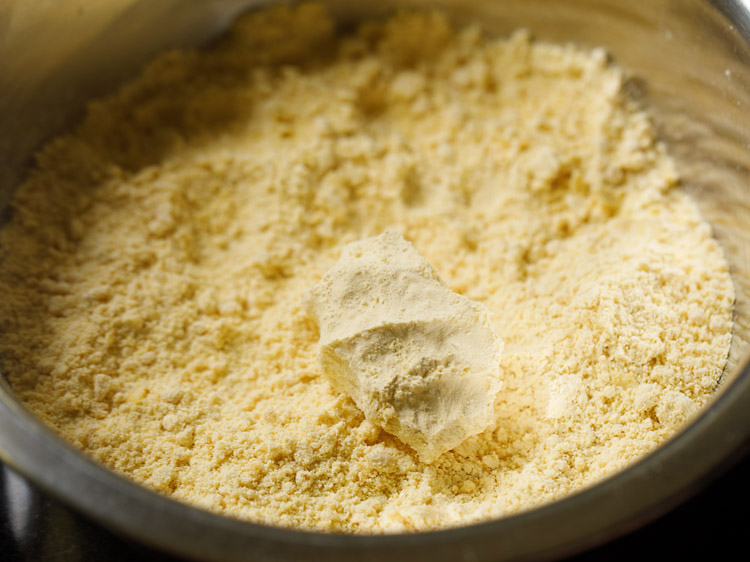
5. Next, start adding water in parts. Amount of water to be added depends on the quality of besan and maida. Overall, you can add 4 to 5 tablespoons water or as required.
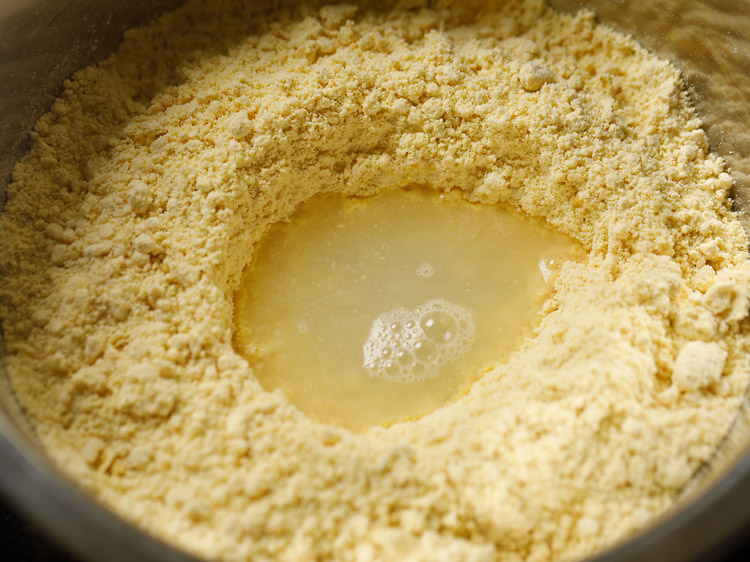
6. Begin to mix and knead the dough.
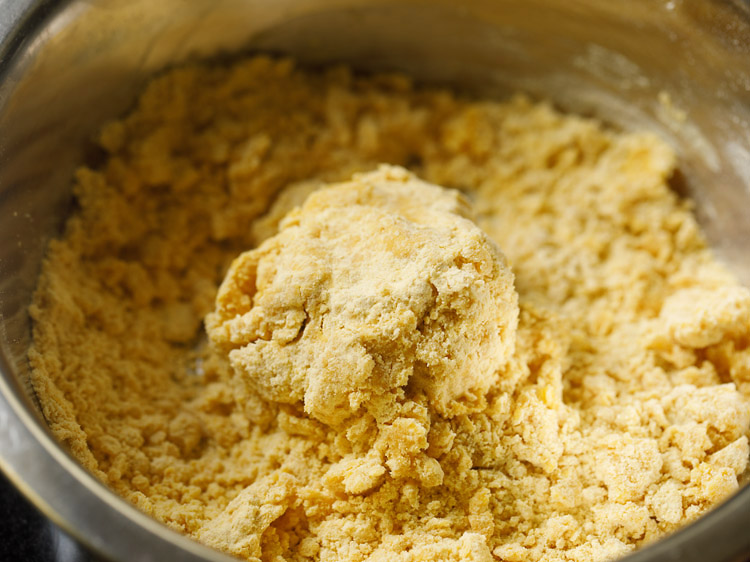
7. Knead to a semi soft dough. In case the dough becomes sticky, add some maida. If it looks dry, sprinkle some water and continue to knead. Cover the dough and keep aside.
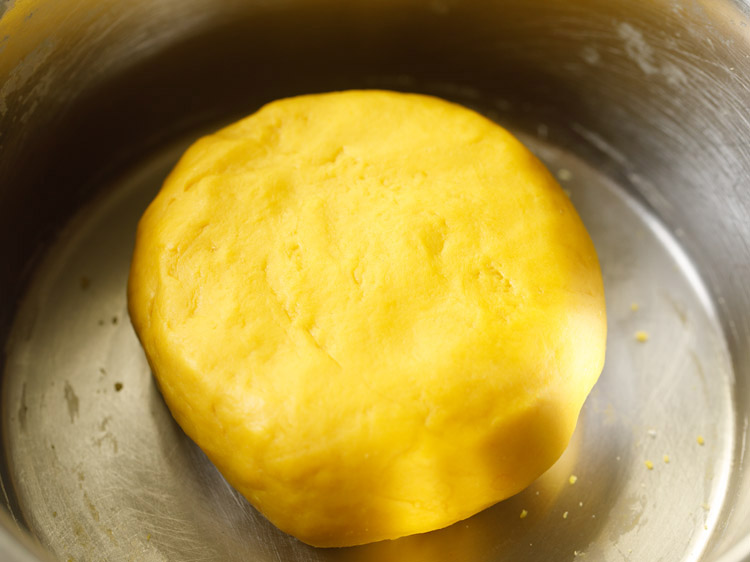
Making stuffing
8. Heat a heavy pan or kadai. Add 2 tablespoons white sesame seeds.
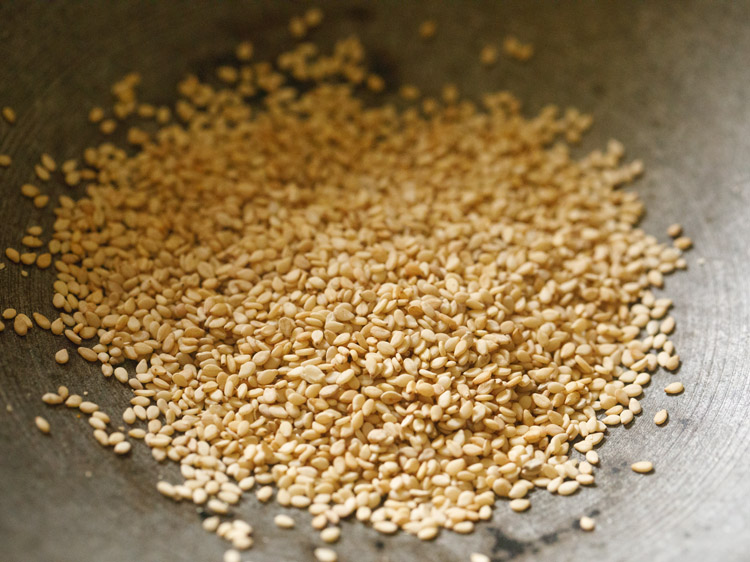
9. On low to medium-low heat, roast sesame seeds till they crackle. Stir often. Do not brown them.
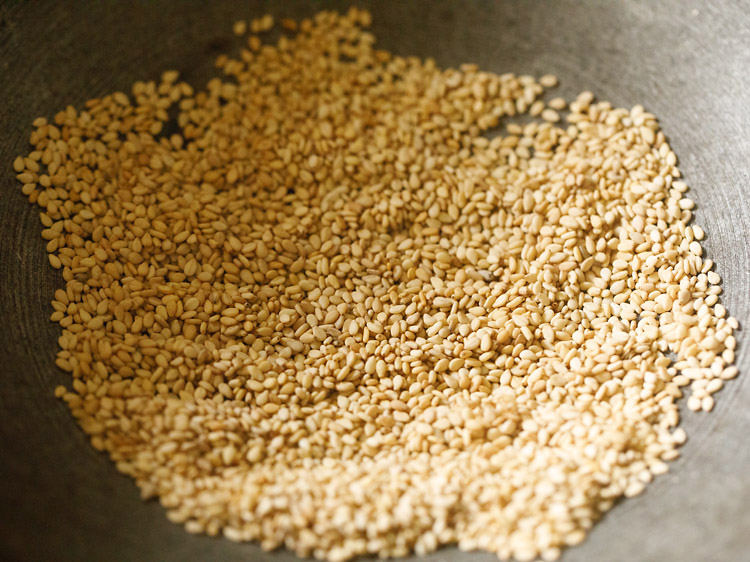
10. Keep the heat to a low, add ½ cup (40 grams) desiccated coconut and 1 tablespoon poppy seeds (khus khus).
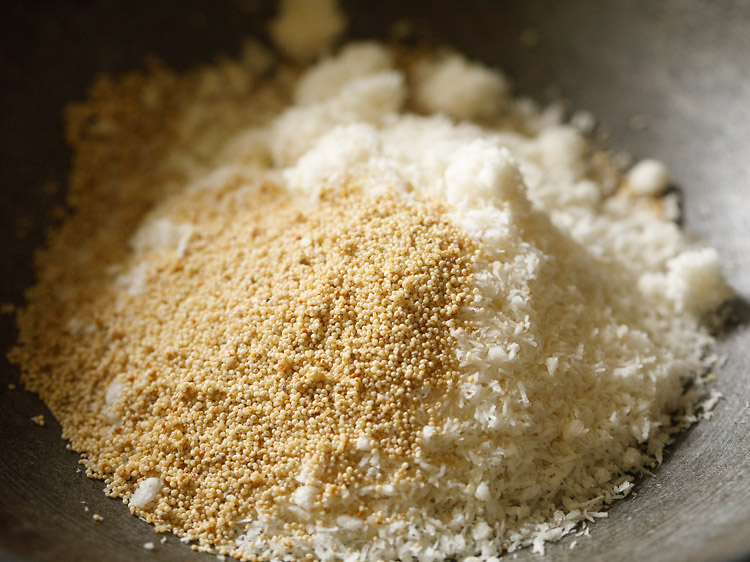
11. Mix very well.
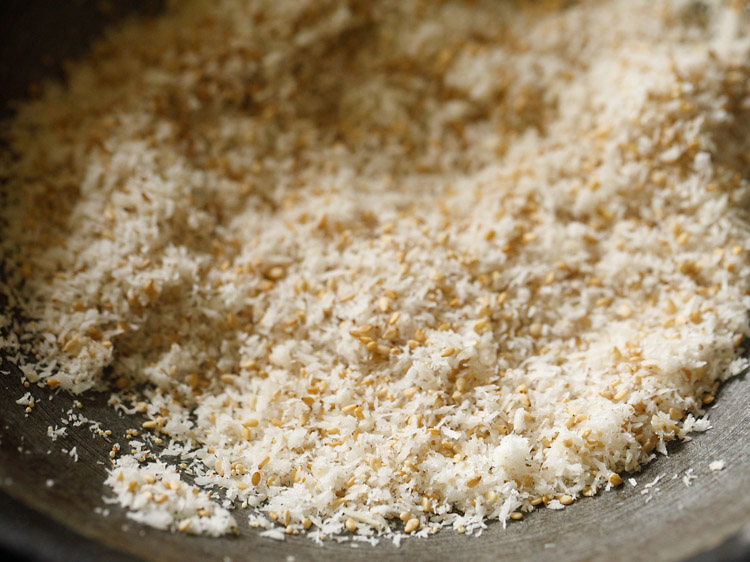
12. Add ½ teaspoon fennel seeds (saunf).
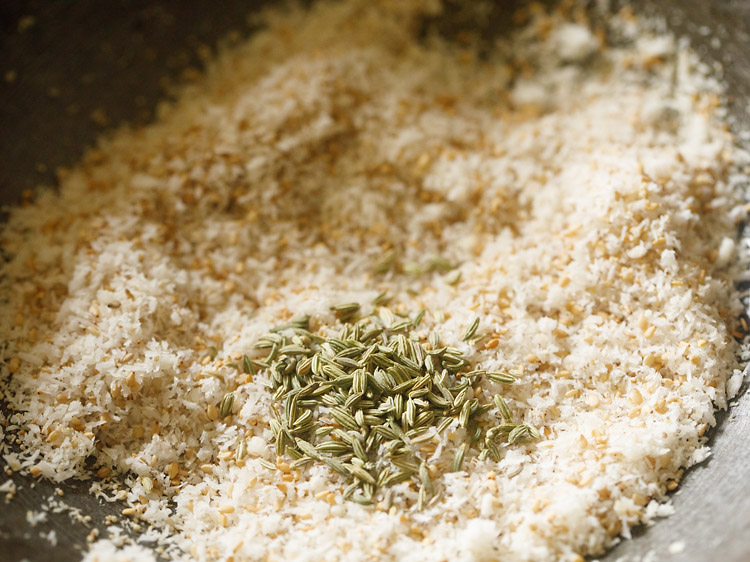
13. Mix again and roast on low heat.
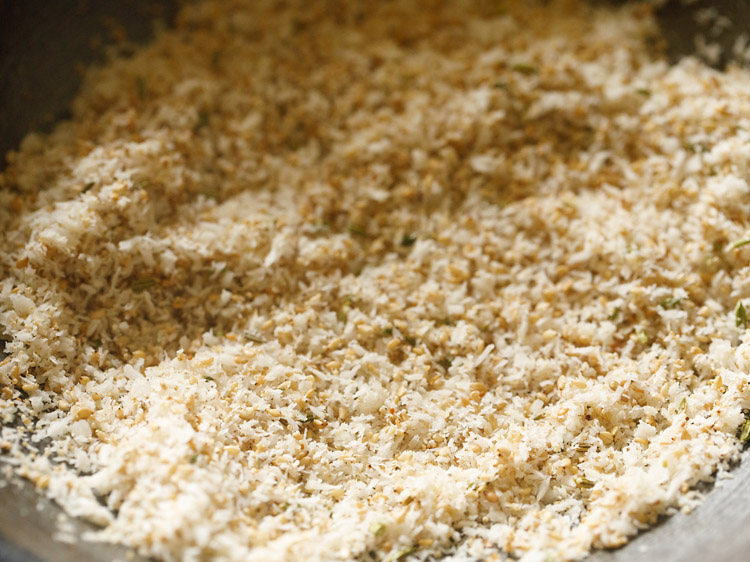
14. Roast till coconut is light golden. Stir non-stop.
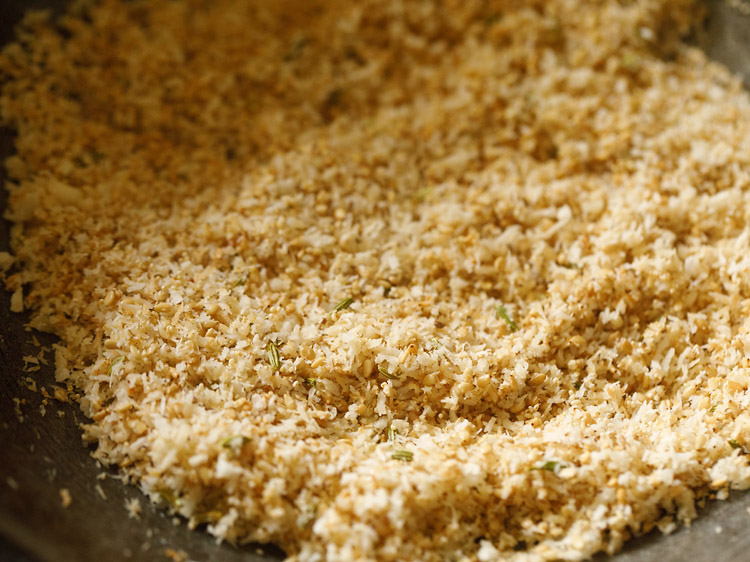
15. Switch off the heat and remove the pan from heat. Add the spice powders one by one – 1 pinch asafoetida, 1 teaspoon Kashmiri red chili powder, 1 teaspoon coriander powder, 1 teaspoon cumin powder and ½ teaspoon garam masala (or ½ teaspoon goda masala). Also, add salt as per taste. The spice powders will get cooked with the residue heat from the pan and the coconut mixture.
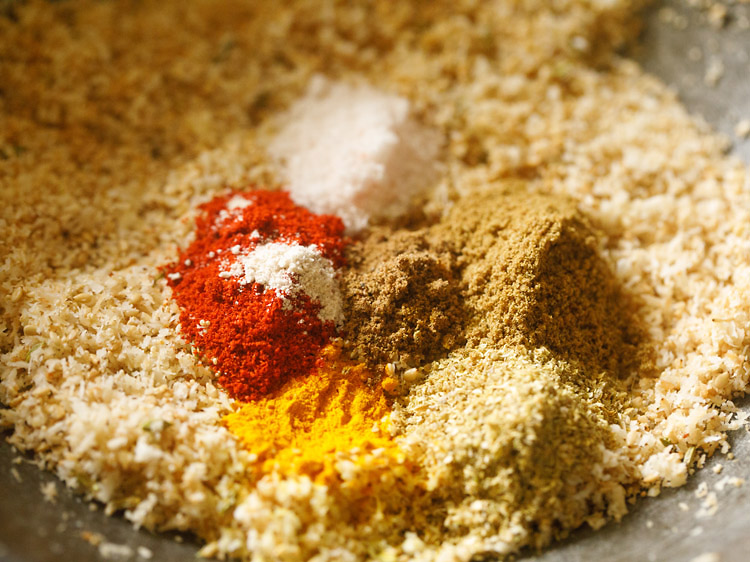
16. Mix very well and let this mixture cool.
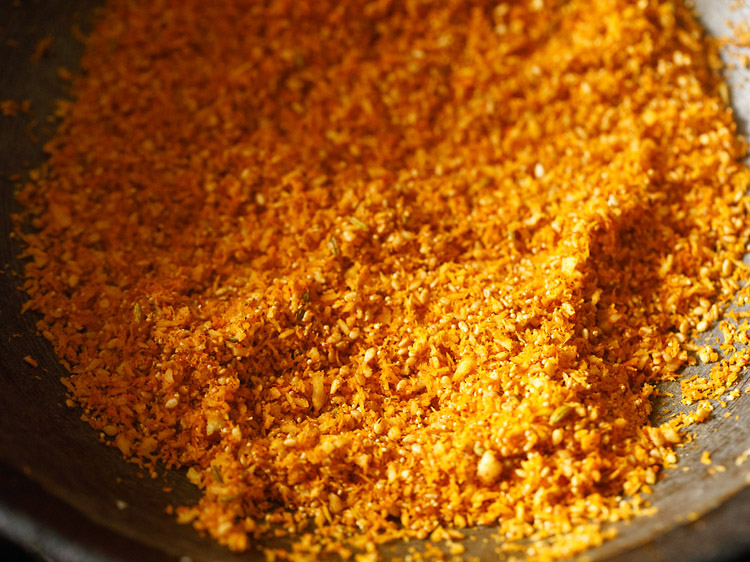
17. Then, take the roasted stuffing mixture in a grinder jar. Add 1.5 to 2 tablespoons sugar. You can add less or mores sugar, as per your taste buds.
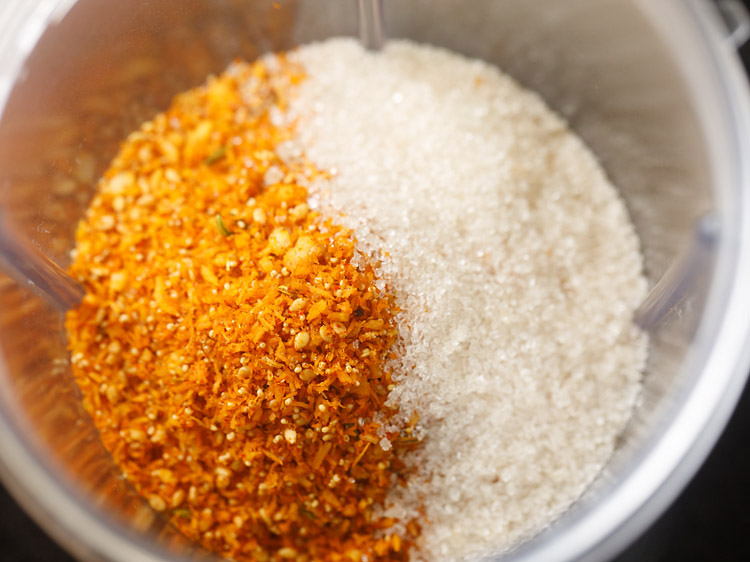
18. Grind to a semi-fine powder. Do not grind fine as then oil releases from coconut and sesame seeds. Use pulse option and grind or grind at intervals of a few seconds.
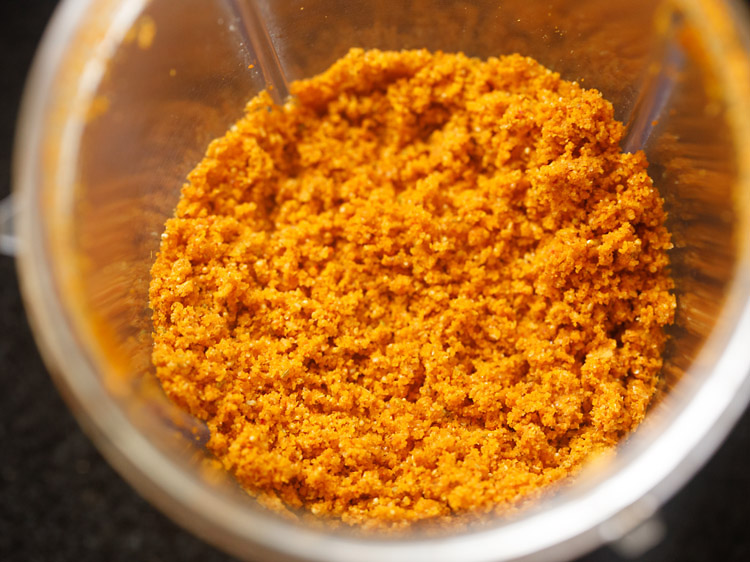
19. Take the prepared stuffing mixture in a bowl. Add ½ tablespoon lemon juice. For a tangier taste, add 1 tablespoon lemon juice. Alternatively, instead of lemon juice, add 1 to 2 teaspoons dried mango powder or 1 to 2 teaspoons of tamarind pulp (not paste). The sourness can be adjusted, by adding less or more of the souring ingredient.
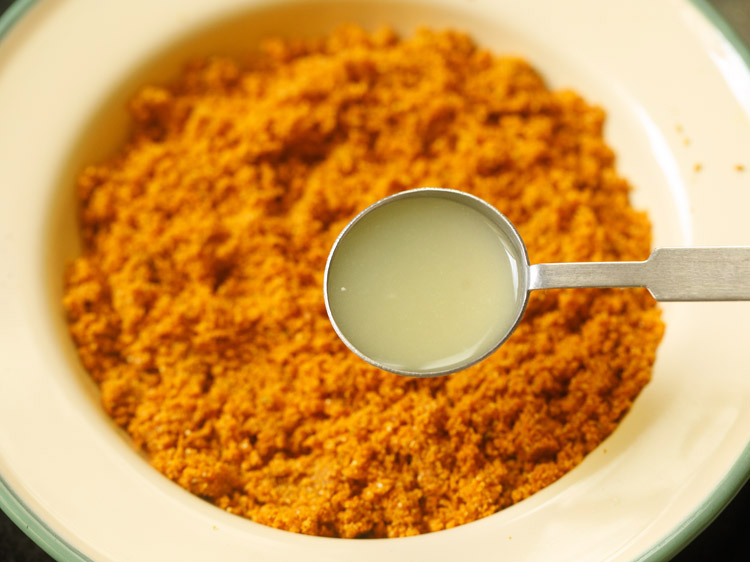
20. Mix very well. Check taste and if required add more salt, sugar, spice powders or lemon juice.
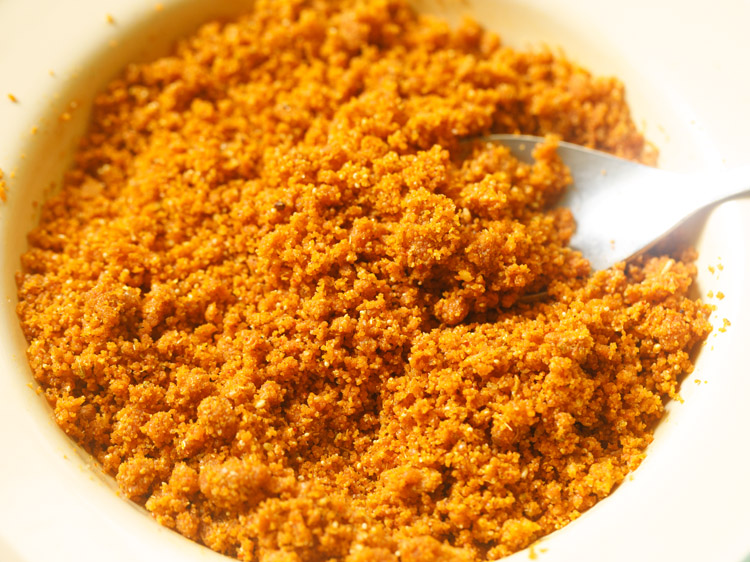
Assembling and making Bhakarwadi
21. Take the dough and roll it into a log. Cut the log into 4 to 5 equal parts.
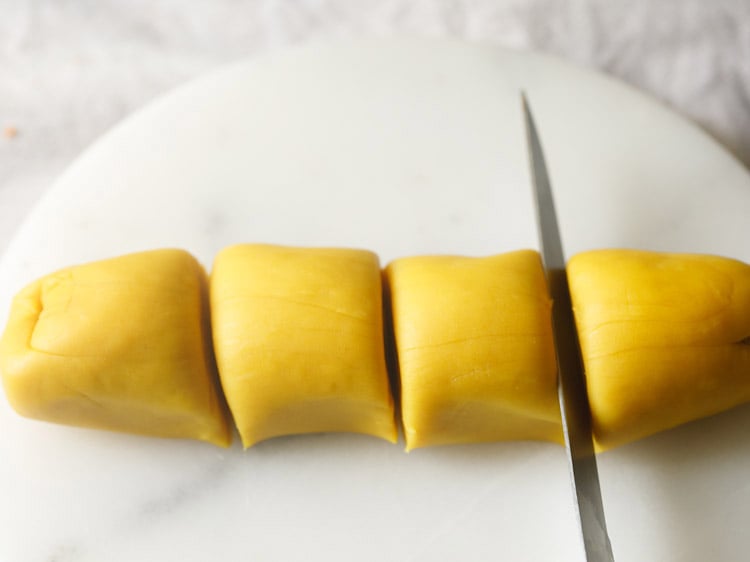
22. Take one part of the dough and roll between your palms to get a round shape. Flatten and keep the dough on a rolling board.
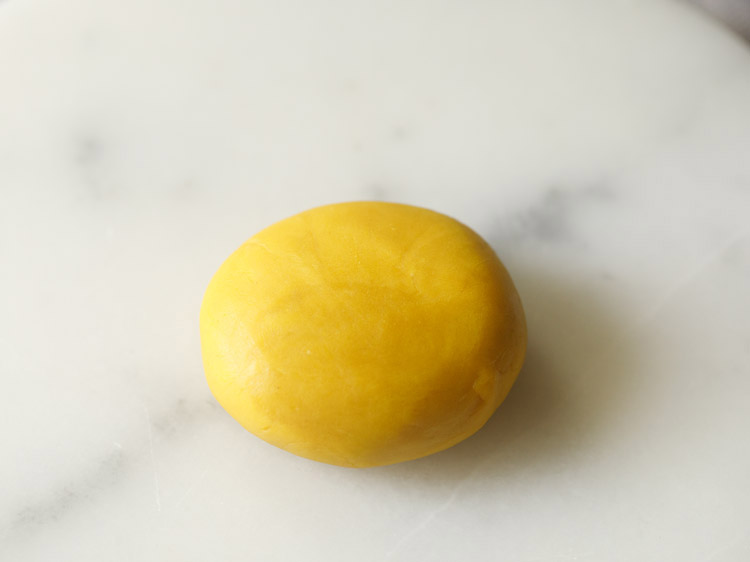
23. Sprinkle some besan before you begin to roll the dough.
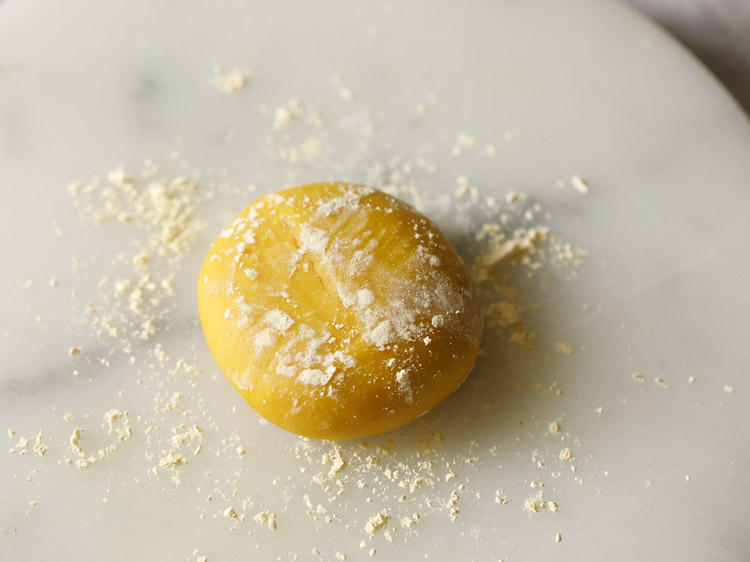
24. Roll to a medium thick round, square or rectangle. Make sure that the dough is not rolled thinly or thickly.
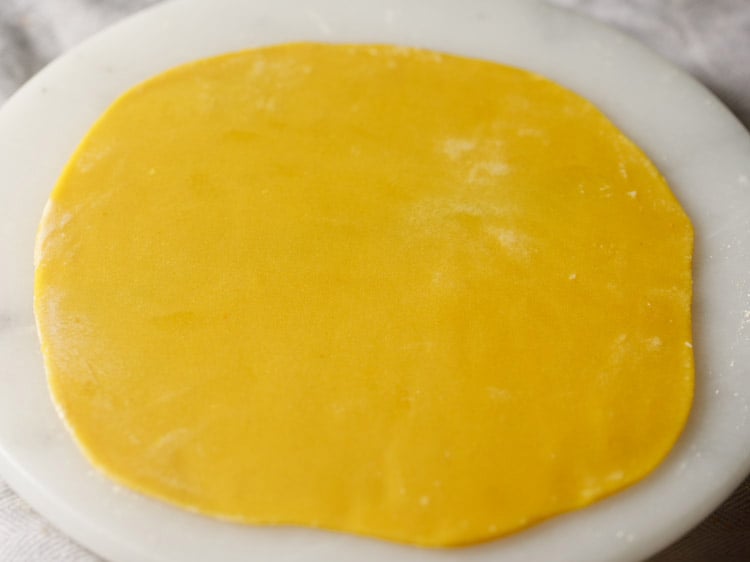
25. Now, brush lightly with water all over the rolled dough.
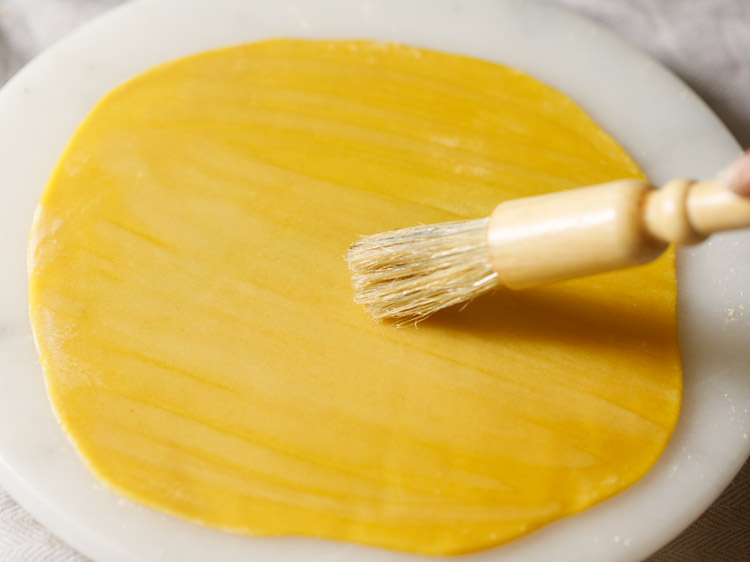
26. With a spoon, spread the prepared stuffing mixture on the dough, leaving a space of ½ to 1 inch at the edges.
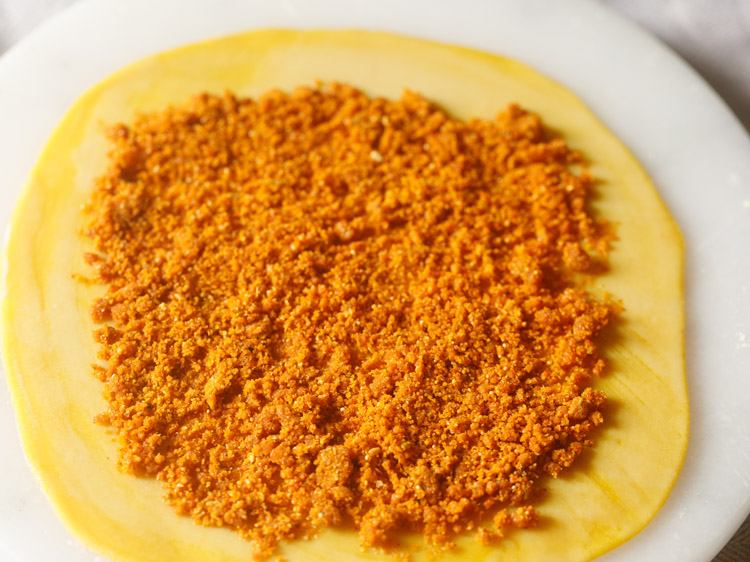
27. Then, lightly press the stuffing mixture with a spoon.
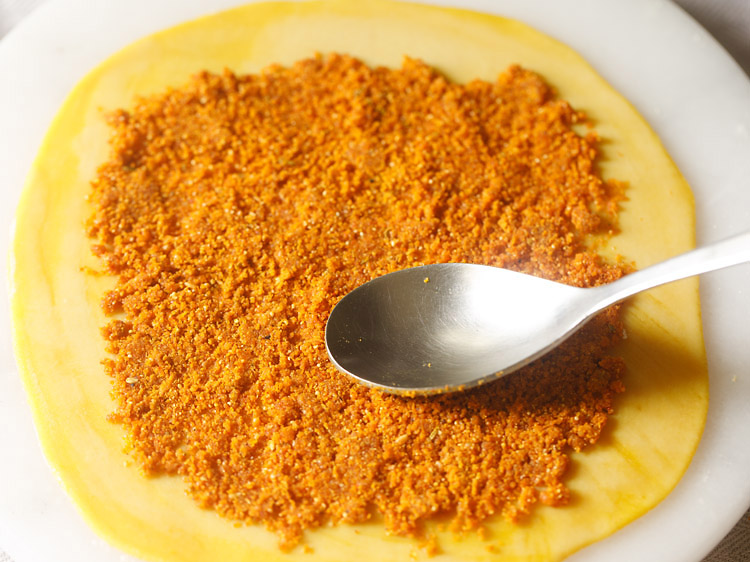
28. Now, begin to tightly roll the dough.

29. Roll to a tight and neat log.
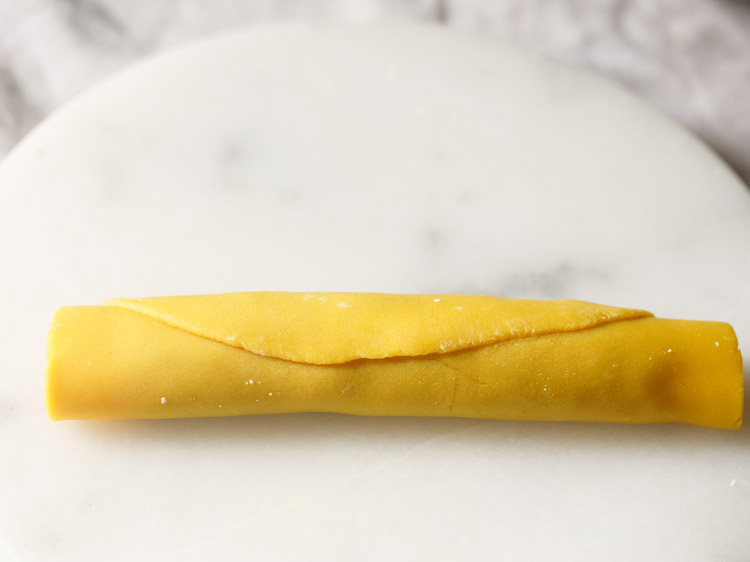
30. Join the edges.
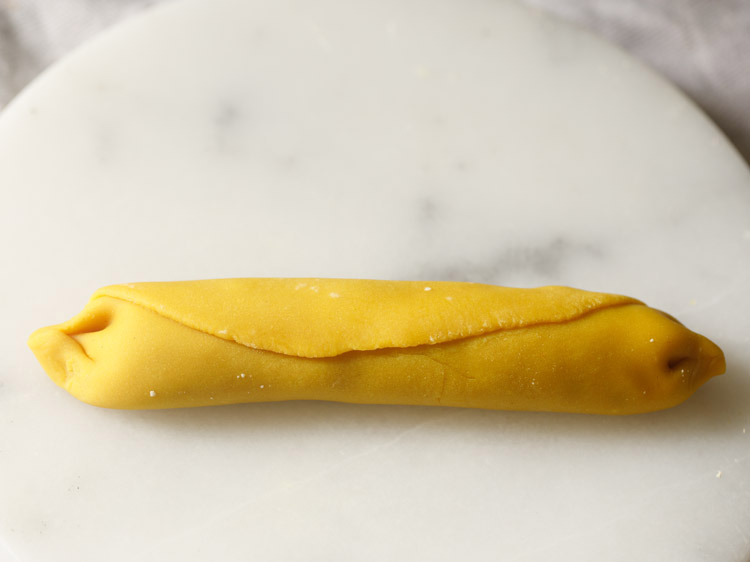
31. Cut the rolled log into equal parts.
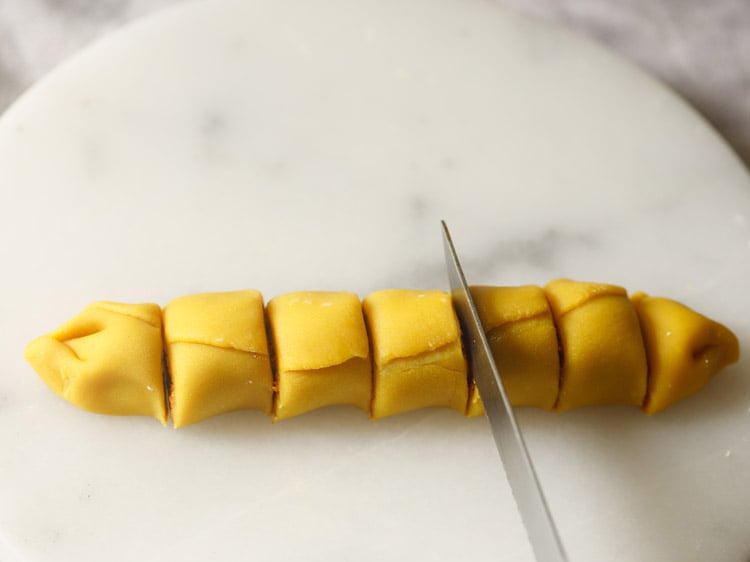
32. You will get Bhakarwadi pinwheels. Place them with the pinwheel surface facing you.
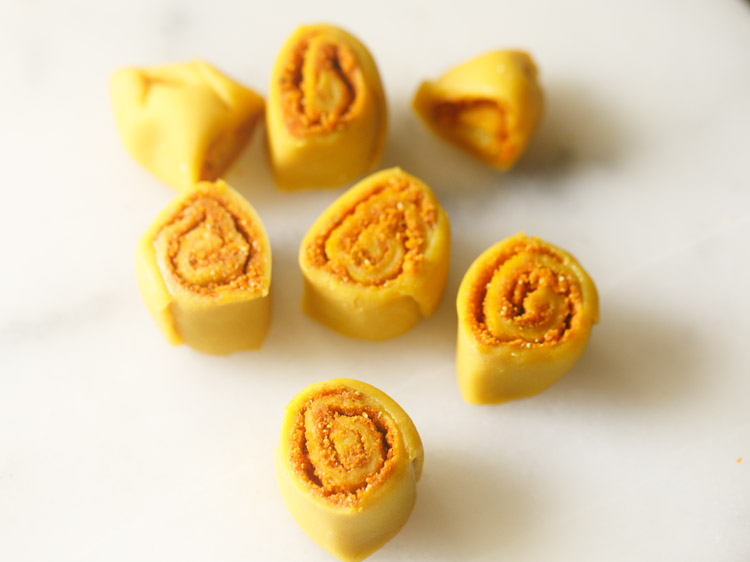
33. Gently press each pinwheel with the heel of your palm.
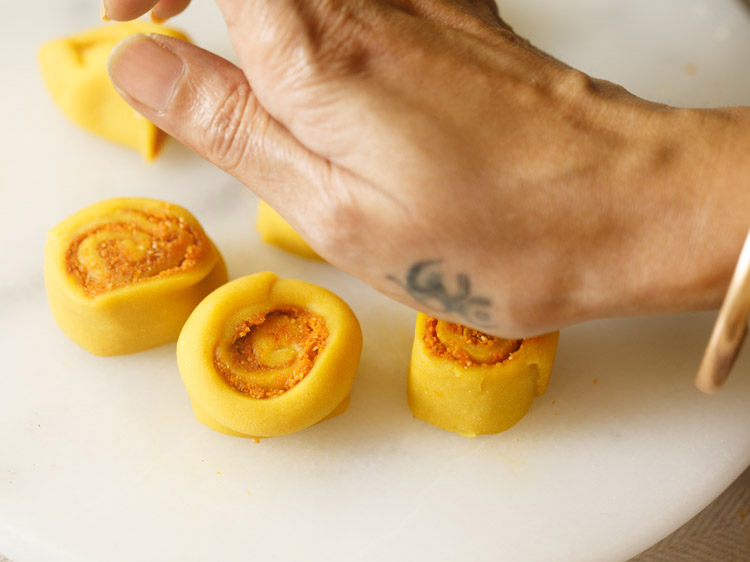
34. Make Bhakarwadi pinwheels with the entire dough and stuffing mixture, similarly. Keep them in a bowl. Cover the bowl.
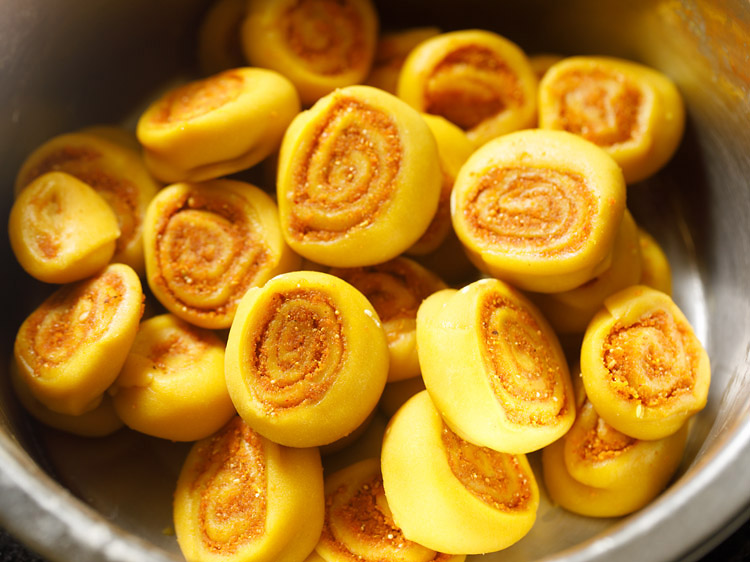
Frying Bhakarwadi
35. Heat oil in a kadai or pan. Keep flame to medium-low or medium. To check if the oil is hot, slide one piece in oil. If it comes up gradually to the surface of oil, you can begin frying. In case it comes up slowly on the surface of oil, then the oil is not hot enough. Then, increase the heat. If it comes up too quickly on the top, then the oil is very hot. So, reduce the heat.
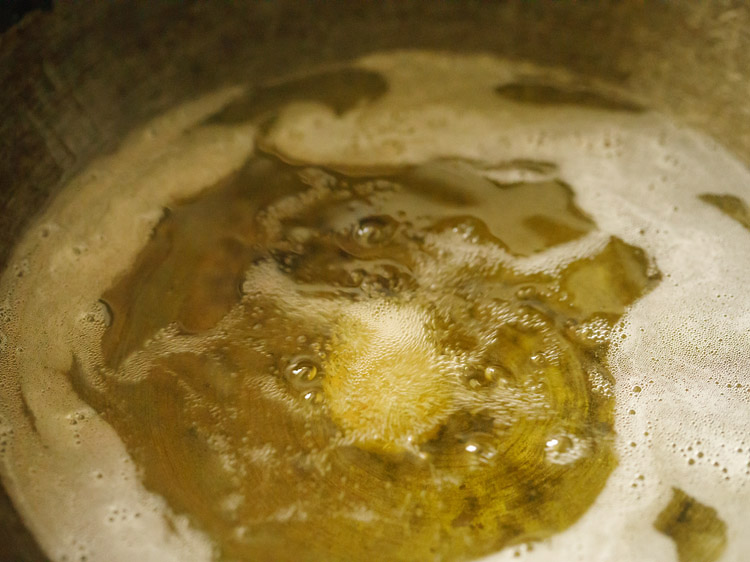
36. Add the Bakarwadi pinwheels in the oil. Do not overcrowd the pan or kadai. Begin to fry on medium-low to medium heat. Do not fry on high heat, as then the center of the Bakarwadi can be slightly soft and uncooked.
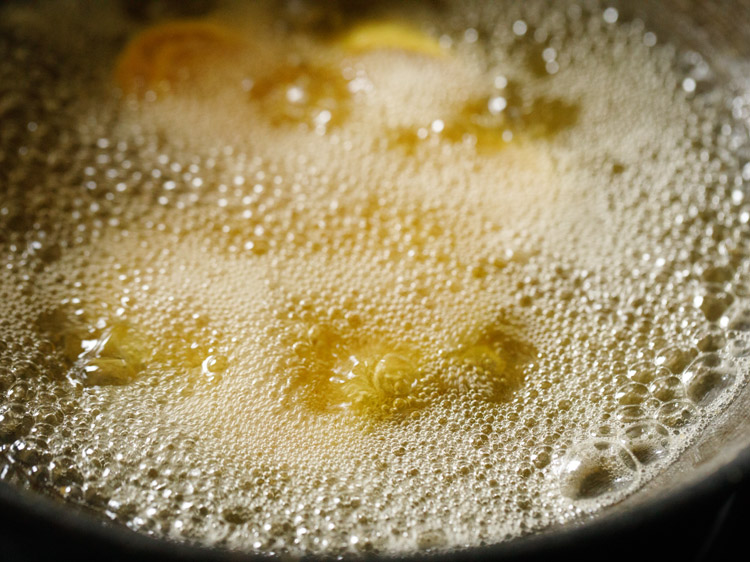
37. When one side is light golden, turn over with as slotted spoon and fry the second side of Bakarwadi.
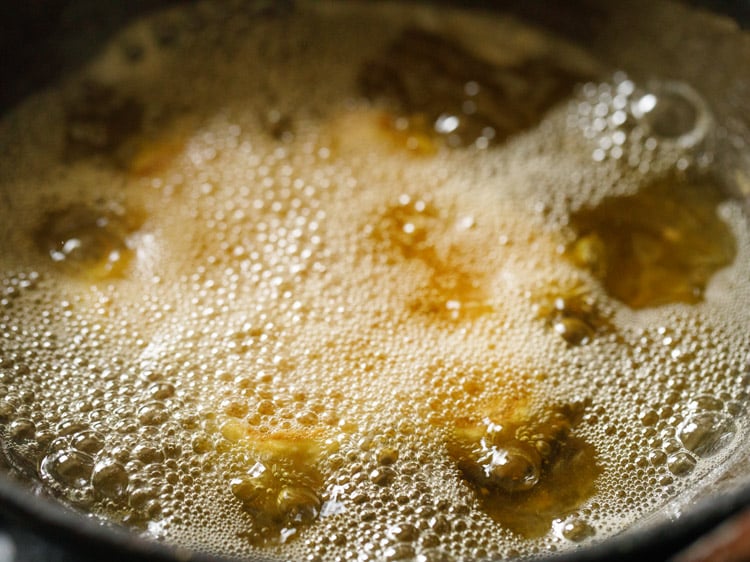
38. Continue to turn Bakarwadi a couple of times to get even golden color.
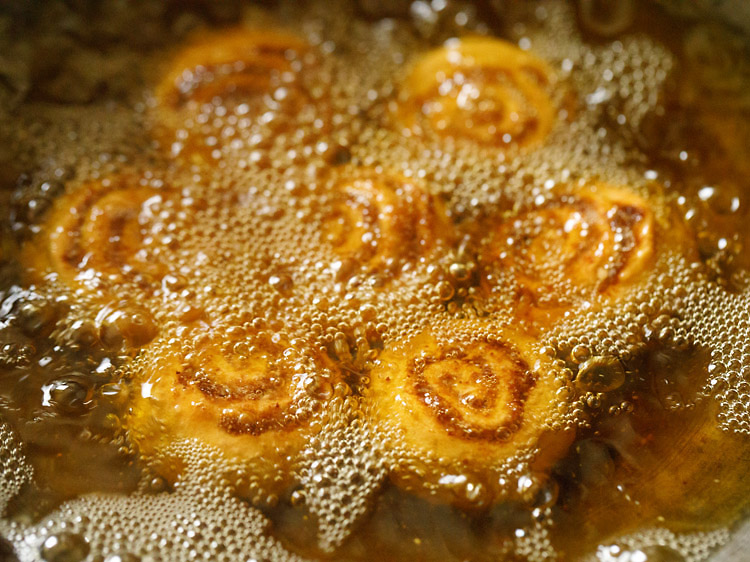
39. Fry till the crust becomes crisp and golden and the oil stops sizzling.
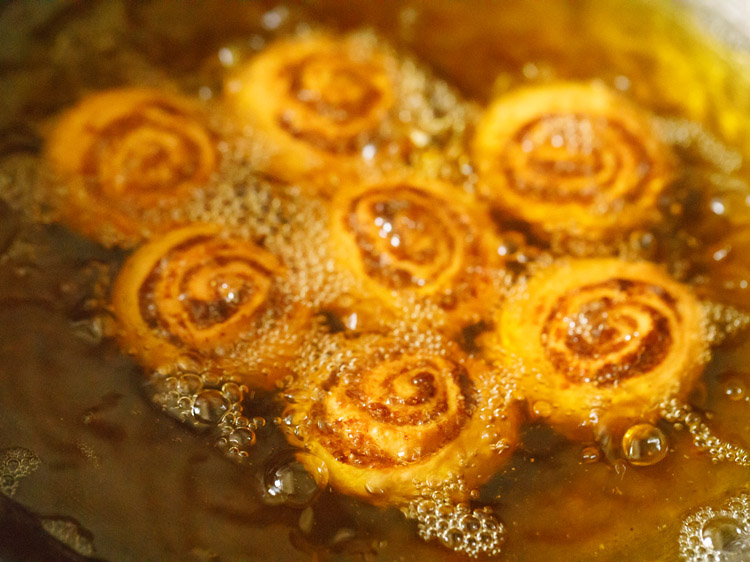
40. Remove the fried Bakarwadi with a slotted spoon, draining extra oil in the kadai itself.
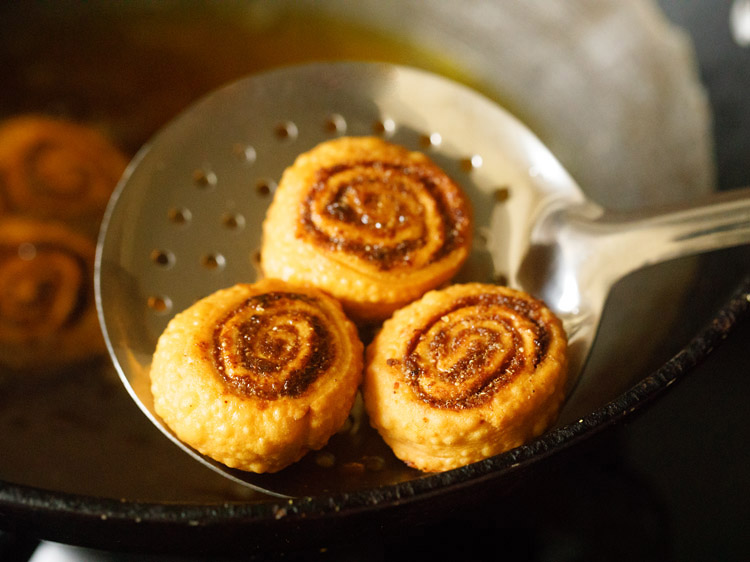
41. Place the fried Bakarwadi on kitchen paper towels. Similarly, fry the remaining.
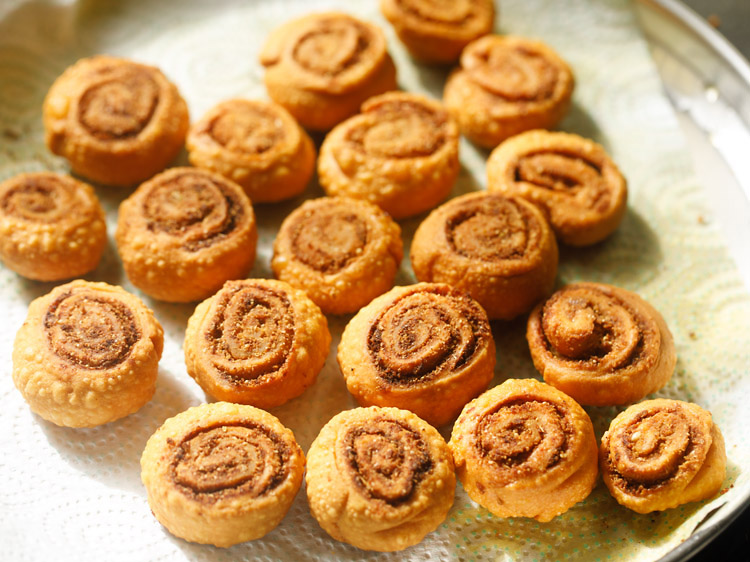
42. When the Bhakarwadi cools to room temperature, serve them as a tea-time snack or place in an air-tight jar or box.
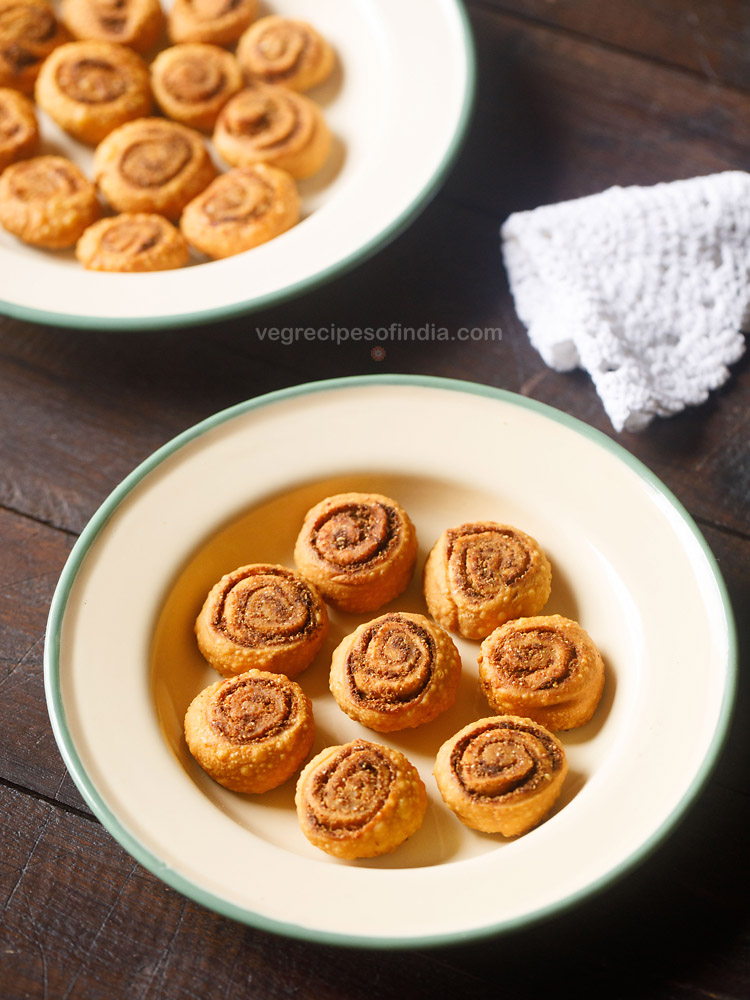
Expert Tips
- You have to mix the oil with the flours till a breadcrumb like texture is formed. The mixture should also be able to hold itself and not crumble.
- Make sure to add water in parts. Overall quantity will depend on the quality of besan and maida.
- If your dough becomes sticky, add some more maida and knead. If dry, add some water and knead. A perfect dough for this Bhakarwadi Recipe has to be a semi-soft one.
- To make a spicier version of this Bhakarwadi Recipe, add more Kashmiri red chili powder.
- For the stuffing mixture, goda masala can be used in place of garam masala powder.
- The quantity of sugar in the stuffing can also be less or more, depending on your taste likings.
- Use the pulse option to grind the stuffing mixture to a semi-fine powder. Do not grind fine as then the coconut and sesame seeds will release their oils.
- You can use lemon juice, 1 to 2 teaspoons tamarind pulp or 1 to 2 teaspoons dried mango powder as the souring agents in the stuffing. Quantities can be less or more.
- You have to roll the dough into a medium-thick disc/square or rectangle. Not thinly or thickly.
- Make sure to fry the Bhakarwadi on medium-low to medium heat. Avoid frying on high heat as then the center of the Bakarwadi will stay uncooked and become slightly soft.
More Indian Snacks Recipes To Try!
Evening Snacks
Evening Snacks
Evening Snacks
Snacks Recipes
Please be sure to rate the recipe in the recipe card or leave a comment below if you have made it. For more vegetarian inspirations, Sign Up for my emails or follow me on Instagram, Youtube, Facebook, Pinterest or Twitter.
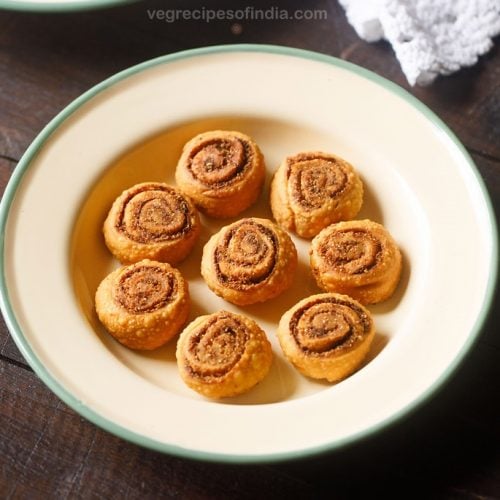
Bhakarwadi
Ingredients
for bhakarwadi dough
- 1 cup besan or 100 grams besan (gram flour)
- ¾ cup maida or 90 to 95 grams maida (all purpose flour)
- ¼ teaspoon turmeric powder (haldi)
- 1 pinch asafoetida (hing)
- ¾ to 1 teaspoon salt or add as required
- 3 tablespoons oil
- 5 tablespoons water or add as required
for bhakarwadi stuffing
- 2 tablespoons white sesame seeds (safed til)
- ½ cup desiccated coconut or 40 grams (nariyal ka boora)
- 1 tablespoon poppy seeds (khus khus)
- ½ teaspoon fennel seeds (saunf)
- 1 pinch asafoetida (hing)
- 1 teaspoon kashmiri red chili powder
- 1 teaspoon Coriander Powder (dhania powder)
- 1 teaspoon cumin powder (jeera powder)
- ½ teaspoon Garam Masala or ½ teaspoon goda masala
- ½ tablespoon lemon juice or add as required
- salt as required
- 1.5 to 2 tablespoons sugar or add as per taste
- oil as required for deep frying
Instructions
making bhakarwadi dough
- In a mixing bowl or large tray or plate, take gram flour (besan), all purpose flour (maida), turmeric powder, asafoetida (hing) and salt.
- With a spoon mix everything well.
- Next add 3 tablespoons oil. with your fingertips, mix the oil with the flours, till you get a bread crumb like texture.
- Take a portion of the flour and press it. It should be able to hold itself and not crumble.
- Next add water in parts. Amount of water to be added depends on the quality of besan and maida, so add in parts and add as required. Overall you can add 4 to 5 tablespoons water or add as required.
- Adding water in parts, begin to mix and knead the dough.
- Knead to a semi soft dough. In case the dough becomes sticky, then add some maida. If it looks dry, then sprinkle some water and continue to knead. Cover the dough and keep aside.
making bhakarwadi stuffing
- Heat a heavy pan or kadai. Add 2 tablespoons white sesame seeds.
- On a low to medium-low flame, stirring often roast sesame seeds till they crackle. Do not brown them.
- Keeping flame to a low, add ½ cup desiccated coconut (40 grams) and 1 tablespoon poppy deeds (khus khus). Mix very well.
- Then Add ½ teaspoon fennel seeds. Mix again and roast on a low flame.
- Stirring non-stop, roast till coconut is light golden.
- Switch off flame and keep the pan down.
- Add the following spice powders one by one – 1 pinch asafoetida, 1 teaspoon kashmiri red chili powder, 1 teaspoon coriander powder, 1 teaspoon cumin powder and ½ teaspoon garam masala (or ½ teaspoon goda masala).
- Also add salt as per taste. The spice powders will get cooked with the residue heat from the pan and the coconut mixture.
- Mix very well and let this mixture cool.
- Then take all of the roasted stuffing mixture in a grinder jar. Add 1.5 to 2 tablespoons sugar. You can add less or mores sugar as per your taste buds.
- Grind to a semi fine powder. Do not grind fine as then oil releases from coconut and sesame seeds. Use pulse option and grind or grind in intervals of a few seconds.
- Take the stuffing in a bowl.
- Add ½ tablespoon lemon juice. For a more tangy taste in bhakarwadi, you can add 1 tablespoon lemon juice. Alternatively add 1 to 2 teaspoons dry mango powder or 1 to 2 teaspoons of tamarind pulp (note: not tamarind paste). The sourness can be made less or more, by adding less or more of the souring ingredient.
- Mix very well. Check taste and if required add more salt, sugar or spice powders or lemon juice.
assembling and making bhakarwadi spirals
- Take the dough and roll it into a log. Cut the log in 4 to 5 equal parts.
- Take one part of the dough and roll between your palms to get a round shape. Flatten and keep the dough on a rolling board.
- Sprinkle some besan before you begin to roll the dough.
- Roll to a medium thick round or square or rectangle (whatever suits you ☺️). Make sure that the dough is not rolled thinly or thickly.
- Now brush lightly with water all over the rolled dough.
- With a spoon spread masala on the dough, leaving a space of ½ to 1 inch at the edges.
- Then lightly press the stuffing masala with a spoon.
- Now begin to tightly roll the dough. roll to a tight and neat log. Then join the edges.
- Cut the rolled log in equal parts.
- You will get the bhakarwadi spirals or pinwheels. Place them with the pinwheel surface facing you.
- Gently press each bhakarwadi pinwheel with the heels of your palm.
- This way make bhakarwadi pinwheels with the entire dough and stuffing mixture. Keep them in a bowl. Cover the bowl.
frying bhakarwadi
- Heat oil in a kadai or pan. Keep flame to medium-low or medium. To check if the oil is hot, slid one bhakarwadi in the oil. If the bhakarwadi comes up gradually to the surface of oil, you can begin frying bhakarwadi.
- Add the bhakarwadi pinwheels in the oil. Do not over crowd the pan or kadai with bhakarwadi. Begin to fry at medium low to medium flame. Do not fry on a high flame as then the center of bhakarwadi can be slightly soft and uncooked.
- When one side is light golden, turn over with a slotted spoon and fry the second side of bhakarwadi.
- Continue to turn a couple of times to get even golden color.
- Fry them till the crust becomes crisp & golden and the oil stops sizzling.
- Remove the fried bakarwadi with a slotted spoon draining extra oil in the kadai itself.
- Place on kitchen paper towels to remove the extra oil. Similarly, fry the remaining bhakarwadi.
- When they cool down at room temperature, then place them in an air-tight jar or box. This recipe yields about 25 to 26 bhakarwadi. Serve them as a tea time snack.
Notes
- This bakarwadi recipe is not spicy. You can add more kashmiri red chili powder for a spicier version.
Nutrition Info (Approximate Values)
This Bhakarwadi Recipe from the archives was first published in January 2018. It has been updated and republished in March 2024.
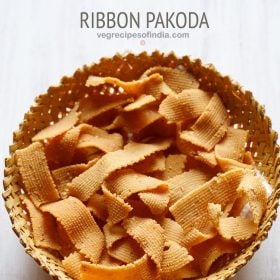
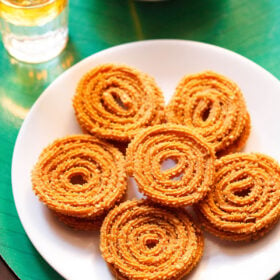
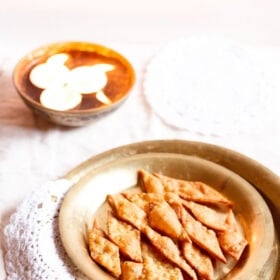
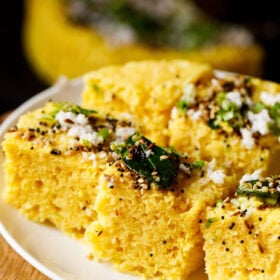
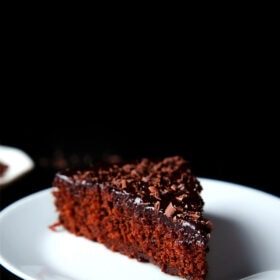
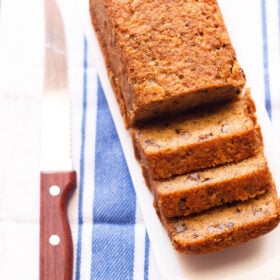
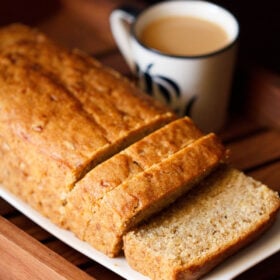
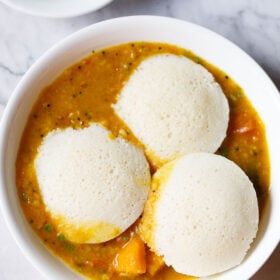








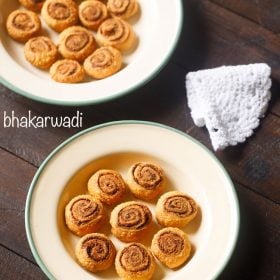
Could I use my air fryer to cook them?
You can try.
Hi,
Is there a substitute for khus-khus or can I skip it entirely? Will it impact the authentic taste of bhakarwadi significantly?
Thanks
There is no substitute for khus-khus. You can skip it entirely. There won’t me much taste change in the recipe except for that of the crunchiness coming from the khus khus.
I made excellent bhakarwadis with this recipe. Gives authentic maharashtrian taste.
thank you apurva for this super feedback on bhakarwadi recipe. so glad to read your comment. thanks for the rating too.
So easy I would try definitely thanks
thanks reena and welcome.
Hi Dassana,
Thanks for your recipe! It looks delicious! Please can you tell me if I can bake the bhakarwadi instead of deep frying please? Do you know the baking temperature and time?
Thanks,
Zeedee
yes you can bake the. preheat oven at 180 degrees celsius for 15 minutes. then bake the bhakarwadi at 180 degrees celsius till they are crisp and golden. brush or spread the tray with some oil. place the bhakarwadi on the tray. brush each bhakarwadi with some oil and then bake.
Thanks for your recipes Dassana, it has helped someone like me to start cooking things that are edible ????. Maybe attempting the bhakarwadi recipe was being a bit too optimistic but I have managed to make quite a few of your recipes quite well as your instructions are detailed and easy to understand even for people to whom cooking was never easy. It’s not just me but I think my husband and son are more thankful that I discovered you. With regards to the bhakarwadi I did press the pinwheel but still the stuffing came out and spread in the oil, where did I go wrong. Thank you once again for making cooking enjoyable. Bless you.
thank you much sindhu. did you brush the dough with water and rolled the dough tightly. also if the dough is not rolled tightly than the stuffing can spread in the oil. did this happen with all the bhakarwadi pinwheels or only a few. you can let me know. you can even bake or air fry bhakarwadi.
Looks Interesting .. I would definitely try it soon ????
thanks and do try.
Thanks Dassana! I had been looking for bhakarwadi recipe for a long time and this is awesome! And thank you for giving those little tips like pressing the pinwheels so that the stuffing doesn’t spill while frying.I airfryed them though.and they came out very nice and crisp.. Could you plz explain what you mean by tamarind pulp and paste? Looking forward for more awesome recipes
thanks kumud for the feedback and review on bhakarwadi recipe. yes they can be air fried and will taste good. thanks for sharing.
tamarind pulp is a less concentrated version where tamarind is soaked in water till it softens. later pulp is extracted from the soaked tamarind by pressing and squeezing it with the fingers or a strainer. tamarind paste is a much concentrated and thick version which is available commercially. so when using tamarind paste, lesser amounts have to be added in the recipe. hope this helps.